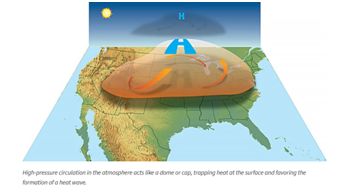Context
A higher degree of temperatures, more than 46-47 degrees Celsius, was recently registered from different parts of Canada and North America. Earlier these highest temperatures were registered in August 1981 and July 1965.
- These high ranges of temperature are part of a "historic" heatwave, a result of a phenomenon referred to as a "heat dome".
About the heat dome
- A heat dome occurs when the atmosphere traps hot ocean air like a lid or cap.
- This happens when strong, high-pressure atmospheric conditions combine with influences from La Niña, creating vast areas of sweltering heat that get trapped under the high-pressure "dome."

- The main cause was a strong change (or gradient) in ocean temperatures from west to east in the tropical Pacific Ocean during the preceding winter.
What causes a heat dome?
- The National Oceanic and Atmospheric Administration (NOAA) says that to understand what causes a heat dome, one should liken the Pacific ocean to a large swimming pool in which the heater is turned on.
- Once the heater is on, the portions of the pool close to the heating jets will warm up faster and therefore, the temperature in that area will be higher.
- In the same way, the western Pacific ocean’s temperatures have increased in the past few decades and are relatively more than the temperature in the eastern Pacific.
- This strong change in ocean temperature from the west to the east is the reason for the heat dome, which is when the atmosphere traps heat at the surface, which encourages the formation of a heatwave.
Are heatwaves dangerous for humans?
- As long as the body is producing sweat, which is then able to evaporate quickly, the body will be able to remain cool even under high temperatures.
- But, there is a limit to this, a limit called the wet-bulb temperature–that considers heat and humidity–beyond which humans cannot tolerate high temperatures.
- Some heat-related illnesses include heat stroke, heat exhaustion, sunburn and heat rashes.
- Sometimes, heat-related illnesses can prove fatal.
Is this heat wave a result of climate change?
It cannot be said for sure if the heatwave is a direct result of global warming.
